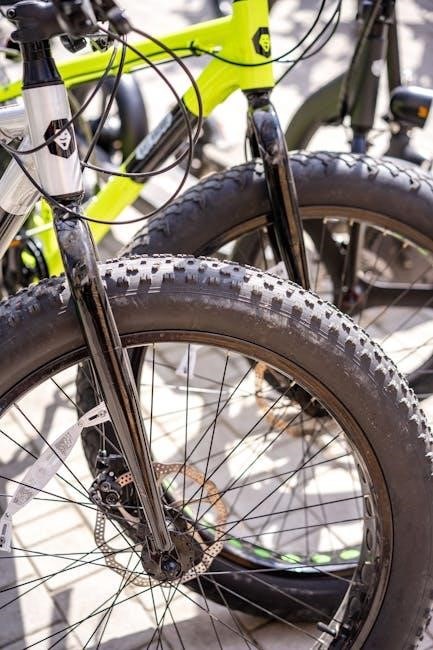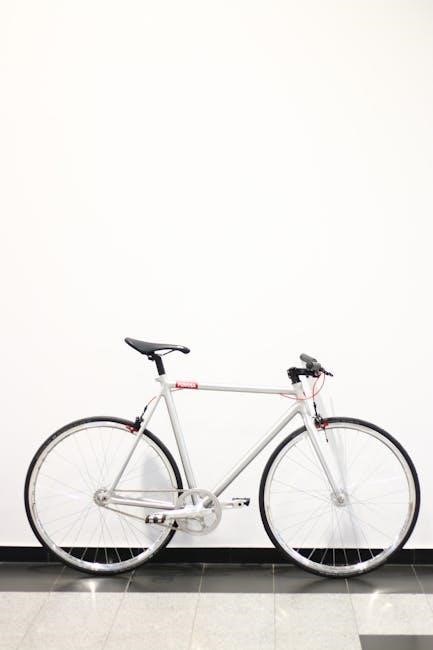Choosing the right bike size is essential for comfort, health, performance, and safety. This guide provides detailed insights and charts to help you select the perfect bike frame size for your needs.
Why Frame Size Matters
Proper bike frame size is crucial for comfort, performance, and safety. A frame that is too small or too large can lead to discomfort, health issues, and poor control. Riding a bike that doesn’t fit your body can cause back pain, knee strain, and shoulder stress, making cycling less enjoyable. Additionally, an ill-fitting frame can hinder your ability to maneuver the bike safely, increasing the risk of accidents. The right frame size ensures optimal pedaling efficiency and handling, allowing you to ride longer and more comfortably. Whether you’re cruising on a road bike or tackling trails on a mountain bike, the frame size directly impacts your overall cycling experience. This guide helps you understand how to choose the perfect fit for your needs.
Consequences of Incorrect Frame Size
Riding a bike with an incorrect frame size can lead to discomfort, health issues, and safety risks. A frame that is too small forces the rider into an unnatural position, causing knee strain, back pain, and shoulder discomfort. Conversely, a frame that is too large makes it difficult to control the bike effectively, increasing the risk of accidents. Poor fit can also reduce pedaling efficiency and make cycling less enjoyable. Over time, improper sizing may lead to long-term injuries, such as lower back pain or knee problems. Ensuring the correct frame size is vital for both performance and safety, allowing riders to enjoy a more comfortable and efficient cycling experience. This guide provides essential tips to avoid these issues and find the perfect fit for your needs.
Methods to Determine Frame Size
Three primary methods help determine the ideal bike frame size: measuring inseam length, using a general size chart, and matching bike type with height for precise fit.
Using Inseam Length for Measurement
Measuring your inseam length is a reliable method to determine your bike frame size. Stand against a wall with your feet shoulder-width apart and measure the distance from the floor to the top of your inner thigh. This measurement helps calculate the ideal frame size by multiplying it by a specific factor, typically 0.70 for road bikes and 0.65 for mountain bikes. For example, an inseam of 78cm would suggest a 54-55cm road bike frame. This method ensures a personalized fit, reducing discomfort and improving performance. Always consider the bike type when applying this formula, as sizing varies between road, mountain, and hybrid bikes.
General Bike Size Chart Based on Height
A general bike size chart is a practical starting point for determining the right frame size. It typically correlates your height with a recommended frame size, ensuring a comfortable and efficient ride. For example, if you’re between 152-158 cm tall, a 47-50 cm frame is suitable for road bikes, while mountain bikes may require a 16-17 inch frame. Similarly, taller riders (175-180 cm) often prefer 54-56 cm road frames or 19-20 inch mountain frames. This chart serves as a baseline, but factors like inseam length and bike type can influence the final choice. Always consider a 2-inch stand-over height for safety and comfort. Refer to specific charts for road, mountain, or hybrid bikes to refine your selection further.
Matching Frame Size by Bike Type and Height
Matching the frame size to your height and bike type is crucial for optimal fit. Road bikes, mountain bikes, and hybrids each have unique sizing requirements. For road bikes, taller riders (175-180 cm) typically need a 54-56 cm frame, while shorter riders (152-158 cm) prefer 47-50 cm. Mountain bikes use inches, with 16-17 inches suitable for 152-158 cm and 19-20 inches for 175-180 cm. Hybrids follow a similar approach, ensuring a 2-inch stand-over height for safety. Always cross-reference your height with the specific bike type to ensure proper fit and comfort. This method offers a more precise guide than general charts, helping you find the perfect bike for your needs.

Bike Types and Their Specific Sizing
Different bike types require tailored sizing approaches. Road bikes emphasize precise fit for efficiency, while mountain bikes prioritize stability and control. Hybrids offer versatility, balancing comfort and performance. Each type has unique sizing standards to ensure optimal fit and riding experience.
Road Bikes: Sizing and Considerations
Road bikes are designed for speed and efficiency, making proper sizing crucial. Frame sizes typically range from 47cm to 62cm, corresponding to rider heights. Use your inseam to calculate the ideal size by multiplying by 0.70, ensuring a comfortable riding position. Consider handlebar reach and saddle height for optimal comfort. Sportive and racing models vary slightly, with sportive bikes offering a more relaxed geometry. Always test ride if possible to ensure the perfect fit. Proper sizing enhances performance, reduces discomfort, and improves safety. Refer to specific manufacturer charts for accurate measurements, as some brands may vary slightly.
Mountain Bikes: Sizing and Fit
Mountain bikes are sized differently than road bikes, with frames measured in inches and categorized from X-Small to XX-Large. The ideal size depends on your height and inseam, ensuring proper stand-over clearance. A general rule is to leave about 2-4 inches of space between the rider and the top tube for comfort and safety. Wheel sizes, such as 27.5″, 29″, or 24″, also play a role in fit and handling. Taller riders may prefer larger wheels for stability, while shorter riders benefit from smaller wheels for better maneuverability; Saddle height and handlebar reach are adjustable, allowing for a customized fit. Always refer to the manufacturer’s size chart for specific models, as variations exist. Proper sizing ensures optimal control, comfort, and performance on trails.
Hybrid Bikes: Size Chart and Fit Tips
Hybrid bikes combine elements of road and mountain bikes, offering versatility for commuting and casual rides. Their sizing is similar to mountain bikes, with frames measured in inches and centimeters. A proper fit ensures comfort and efficiency. Stand-over height is crucial, with a recommended 2-inch clearance for safety. Saddle height should allow a slight bend in the knee when the pedal is at its lowest point. Handlebar reach should be adjusted to maintain an upright riding position, reducing strain on the neck and shoulders. Refer to the size chart, which typically ranges from X-Small to XX-Large, matching your height to the appropriate frame size. Additionally, consider wheel size, as larger wheels provide stability while smaller ones enhance maneuverability. Adjusting these elements ensures a tailored fit, making your riding experience enjoyable and stress-free. Regular adjustments can optimize comfort and performance over time.
Beach Cruisers: Size and Wheel Diameter
Beach cruisers are designed for comfort and leisurely rides, often featuring a relaxed riding position. Their size is determined by both frame size and wheel diameter. Frame sizes typically cater to all ages, with options for kids and adults. To ensure a proper fit, consider your height and inseam length. A general rule is to match your height to the recommended frame size using a sizing chart. Wheel diameter is another key factor, with larger wheels providing stability and smaller ones offering easier maneuverability. Stand-over height is also important, allowing at least 2 inches of clearance for comfort and safety. By focusing on these elements, you can find a beach cruiser that suits your needs, ensuring a enjoyable and comfortable riding experience. Proper sizing enhances both comfort and performance, making your rides more enjoyable.
BMX Bikes: Wheel Size and Fit Guide
BMX bikes are known for their durability and versatility, making them popular for tricks, racing, and casual rides. Unlike other bikes, BMX sizing focuses more on wheel size rather than frame size. Common wheel sizes include 16″, 18″, 20″, and 24″, with 20″ being the most common for BMX bikes. The wheel size determines the bike’s handling and suitability for different riding styles. For example, smaller wheels (16″-18″) are ideal for younger riders or tricks, while larger wheels (24″) offer stability and speed. When choosing a BMX bike, consider the rider’s height and inseam to ensure proper fit. A general rule is to match the rider’s height with the recommended wheel size using a sizing chart. Proper fit ensures control, comfort, and optimal performance, whether riding in the park or on the streets. Always check manufacturer guidelines for specific recommendations.

Ensuring Proper Fit
Proper bike fit is crucial for comfort, efficiency, and safety. Factors like stand-over height, saddle height, and handlebar reach ensure a perfect riding position. Adjustments can significantly enhance your cycling experience.
Stand-over height is the vertical distance between the bike’s top tube and the ground. Proper stand-over clearance ensures safety and comfort. For a safe fit, there should be at least 2-4 inches (5-10 cm) of space when standing over the frame with both feet flat on the ground. This clearance allows for easy mounting and dismounting and helps prevent discomfort or injury. Measuring stand-over height is especially important for bikes with a high top tube, such as some road bikes or mountain bikes. If the stand-over height is too low, you may experience discomfort or difficulty controlling the bike. Always check this measurement before finalizing your bike purchase or adjustment. Proper stand-over height is a key factor in achieving a safe and enjoyable riding experience. Proper saddle height is crucial for comfort, efficiency, and injury prevention. When the saddle is too low, it can cause knee pain and reduce pedaling efficiency. If it’s too high, it may lead to discomfort and difficulty controlling the bike. To adjust the saddle height correctly, stand next to the bike and raise the saddle until your leg is almost fully extended when the pedal is at its lowest point. For road bikes, aim for a slight bend in the knee (about 10-15 degrees), while mountain bikes may require a bit more bend due to rough terrain. Always test the height by riding and adjust as needed. Proper saddle height ensures optimal performance and reduces the risk of discomfort or pain during long rides. Handlebar reach significantly impacts comfort, efficiency, and control while cycling. A proper reach ensures a relaxed riding posture, preventing strain on the neck, shoulders, and back. For road bikes, the handlebar reach is often shorter than on mountain bikes, as it prioritizes aerodynamics and speed. To adjust the handlebar reach, position yourself on the bike and ensure the handlebars are within a natural hand stretch. The axle of the front wheel should align with the handlebar ends when viewed from above. If the reach feels too long, consider shorter handlebars or a stem with adjustable length. For mountain bikes, a slightly longer reach improves stability on rough terrain. Always test the setup during a ride to ensure comfort and optimal performance. Proper handlebar adjustment enhances the overall cycling experience. Proper bike fit is vital for comfort, safety, and performance. It prevents health issues like back pain and ensures optimal control while cycling, enhancing overall riding efficiency. A bike that doesn’t fit properly can lead to various health issues, including back pain, knee strain, and shoulder discomfort. Riding a bike that is too small or too large forces the body into an unnatural position, causing unnecessary strain on muscles and joints. Over time, this can result in long-term problems such as chronic pain or even injuries. For example, a saddle that is too high can lead to knee pain, while a handlebar that is too far away can strain the neck and shoulders. Additionally, poor fit can make it difficult to control the bike, increasing the risk of accidents. To avoid these health implications, it’s crucial to ensure the bike is sized correctly for your body. Proper adjustments, such as saddle height and handlebar reach, can significantly improve comfort and reduce the risk of injury. Always prioritize a bike that fits your frame and riding style. A bike with an incorrect frame size can pose significant safety risks. A frame that is too large or too small can make the bike difficult to control, especially during sharp turns or quick maneuvers. If the stand-over height is insufficient, you may struggle to maintain balance, increasing the likelihood of falls. Additionally, an ill-fitting bike can lead to poor posture, which may result in loss of control. For instance, overreaching to the handlebars can cause back strain and reduce your ability to steer effectively. Similarly, a saddle that is too low can limit leg movement, making it harder to maintain balance and power. These issues are particularly dangerous on uneven terrain or when obstacle avoidance is necessary. Ensuring the correct frame size is crucial for safe and confident riding, as it directly impacts your ability to handle the bike in various conditions. Proper fit is essential to minimize risks and maximize control. A correctly sized bike frame significantly enhances both performance and comfort. When the frame matches your body dimensions, it ensures optimal pedaling efficiency and energy transfer, allowing you to ride longer and faster with less fatigue. Proper fit also improves handling, making the bike more responsive to your movements. Comfort is maximized when the saddle height and handlebar reach are adjusted to your body, reducing strain on your back, neck, and shoulders. A well-fitted bike promotes a more aerodynamic position for road bikes and better control for mountain bikes. Additionally, correct sizing prevents discomfort and pain, enabling you to enjoy your rides without distractions. Investing time in finding the right frame size ensures a more enjoyable and efficient cycling experience, whether you’re racing, touring, or commuting. This balance of performance and comfort is key to unlocking your full cycling potential. Different manufacturers like Specialized and Trek offer unique sizing approaches. Specialized uses trail bike sizing charts, while Trek employs an Alpha sizing model for their MTBs, ensuring precise fit and performance. Specialized bikes feature a unique sizing system tailored to rider height and bike type. Their trail bikes are divided into six frame sizes, each corresponding to specific height ranges for optimal stability. This approach ensures a precise fit, enhancing comfort and performance. Riders can refer to Specialized’s charts for accurate sizing. Trek Bikes employs the Alpha Sizing Model, a simplified approach to frame sizing that uses alpha designations (S, M, L, XL) instead of numeric measurements. This system is designed to make frame size selection easier for riders, as it aligns with their height ranges. For mountain bikes, Trek offers four alpha sizes, each corresponding to specific height brackets. This method ensures consistency across Trek’s MTB lineup, providing a more intuitive fit for riders. While other brands use numeric sizing, Trek’s Alpha Model focuses on rider height to determine the ideal frame size. This approach streamlines the selection process, making it easier for riders to find a bike that fits comfortably and performs optimally. The Alpha Sizing Model is particularly beneficial for those new to buying bikes, as it eliminates the complexity of traditional sizing charts.Stand-Over Height: What You Need to Know
Saddle Height Adjustment for Comfort
Handlebar Reach: Importance and Adjustment

Importance of Proper Fit
Health Implications of Poor Fit
Safety Concerns with Incorrect Size
Performance and Comfort

Manufacturer-Specific Guides
Specialized Bikes: Unique Sizing Approach
Trek Bikes: Alpha Sizing Model
Selecting the correct bike frame size is crucial for a safe, comfortable, and enjoyable cycling experience. By understanding your body measurements, bike type, and manufacturer-specific sizing charts, you can make an informed decision. Whether you’re riding a road bike, mountain bike, or hybrid, proper fit ensures optimal performance and reduces the risk of discomfort or injury. Remember, sizing can vary between brands, so consulting the manufacturer’s guide is essential. Always test ride if possible and adjust components like saddle height and handlebars for personalized comfort. With the right frame size, you’ll enjoy better control, efficiency, and overall satisfaction on every ride.
